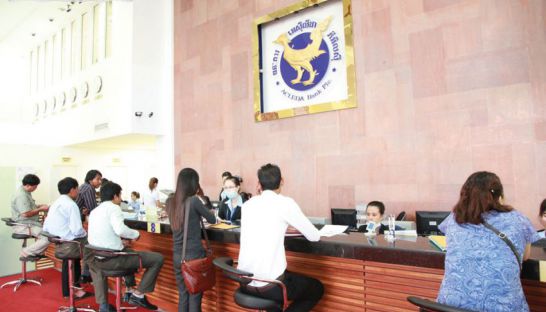Credit shows signs of cooling off
Credit shows signs of cooling off
Credit growth in Cambodia saw a marginal slowdown last year while deposits continued to increase sharply, a combination that some in the financial sector believe reflects a more cautious lending environment and central bank interventionist policies beginning to take hold.

The National Bank of Cambodia (NBC) announced yesterday in its annual report that credit growth has gradually slowed in recent years from 31 percent in 2014 down to 23 percent in 2016. Overall credit issued by banks and MFIs was $16.9 million last year, while deposits grew by about 21 percent to $15.1 billion, spurred by a low base of customers beginning to use financial services.
Nevertheless, the pace of credit growth continues to weigh heavily on the financial sector, leading to numerous calls by global financial institutions to cool bank lending.
Last July, the International Monetary Fund (IMF) billed Cambodia’s rapid credit growth as the “main downside risk” that “threatens to undermine economic and financial stability,” especially given its high concentration in the real estate sector.
Following warnings, the NBC began to strengthen its regulation on the Liquidity Coverage Ratio (LCR) – aiming for all banks to have 100-percent cash on hand of outstanding loans by 2020 – as well as boosting the minimum capital requirement to encourage a “soft landing” of the credit cycle.
“These measures coupled with the market conditions have reduced credit growth gradually, and 2017 credit growth rate is expected to slow to 21 percent,” the NBC stated in its recent macroeconomic year-end review and forecast. It added that market and regulatory conditions have urged “banks and microfinance institutions to diversify their sources of income beyond interest income in order to ensure the sustainability of their businesses.”
So Phonnary, vice president of Acleda Bank, Cambodia’s largest bank by assets, said that the projected 21 percent credit growth in 2017 was still strong enough to promote the Kingdom’s projected nearly 7 percent GDP growth.
However, she said credit growth needs to be monitored closely and financial markets need to “evolve in order to manage the risk of credit properly”.
“There has been a shift in the market to ensure that financial institutions follow regulations and focus more on better loan quality,” she said.
Bun Yin, CEO of CIMB Bank Plc, said that while credit growth will likely continue a gradual slowdown, the slowdown was likely due to the larger loan base, which resulted in the volume of loans registering a lower percentage.
“Industry loan-to-deposit ratio has risen to over 100 percent and this has inevitably affected lending momentum,” he said.
While Yin commended the central bank’s prudential measures to stabilise credit growth, he said it would be difficult to curb the developing country’s natural appetite for credit.
“We believe that the demand for credit in Cambodia is still strong, as a developing country,” he said, adding that due to the relatively under-banked population, “there is more upside to be seen for consumer credit demand, especially in the mid-term.”
Nevertheless, Stephen Higgins, managing partner of investment firm Mekong Strategic Partners, said that the credit slowdown was merely “only in the mathematical sense” and that 2017 was set to break credit lending records.
“A 21 percent credit growth is still very fast, and likely to be one of the fastest rates of growth globally in 2017,” he said, adding that in absolute terms, it “would mean almost $4 billion in additional credit in the system, which is a bigger increase than we’ve ever seen.”
“At these rates of growth, our prediction from two years ago that credit would reach $30 billion by 2020, which most saw as wildly optimistic, will prove way too low,” he said.
While he agreed that the NBC has taken the appropriate measures to put credit growth on a sustainable footing, he advocated for a growth range to fall within 15 to 20 percent.
David Totten, director of Emerging Markets Consulting, said that while NBC policy had likely helped cool credit growth, any slowdown could be due to larger concerns over a real estate-fuelled credit bubble a widely held industry belief.
“I imagine most realise the risk of disproportion credit exposure to a single sector,” he said. “But that does not necessarily translate to behaviour change, in terms of lending, due to the high competition in the banking sector.”













